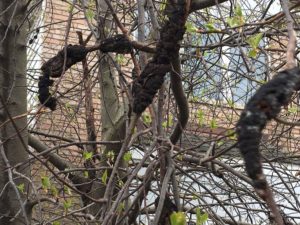Q.I’m concerned about the black sacs shown in this picture that are on a tree in our yard. I’m not sure what type of tree this is, but it is approximately 8 years old. The leaves turn purple in the fall instead of any other color. Is this an infestation that can be cured, or does the tree need to be removed? – D. L., Muenster, Indiana
A. This appears to be a fungal disease called black knot, which is very common on certain Prunus species – most notably ornamental and fruiting plum, cherry, and chokecherry. Since you mentioned the purple fall color, I suspect you have an ornamental plum or possibly chokecherry.
The fungus enters young twigs, branches and fruit stems, which causes abnormal growth and swelling of the bark and wood. The fungus galls enlarge quickly into a black, hard knot. These knots girdle the twig or branch, which causes it to dieback. The galls also release spores that spread the disease.
To manage black knot, prune out the galls as soon as you notice them. Cut back 6-8 inches below the gall to a healthy bud or side branch. You can also prevent future infection (but not “cure” an existing one) if you applying the fungicide chlorothalonil or lime sulfur just before the trees begin spring growth. However, if you see the infection in just the one tree, you can likely manage it with pruning.
From your photo, it looks like the plant is a bit overgrown and crowded, which can favor disease infection. Pruning for better air circulation can help. You’ll find information about pruning techniques in Pruning Ornamental Trees and Shrubs.
